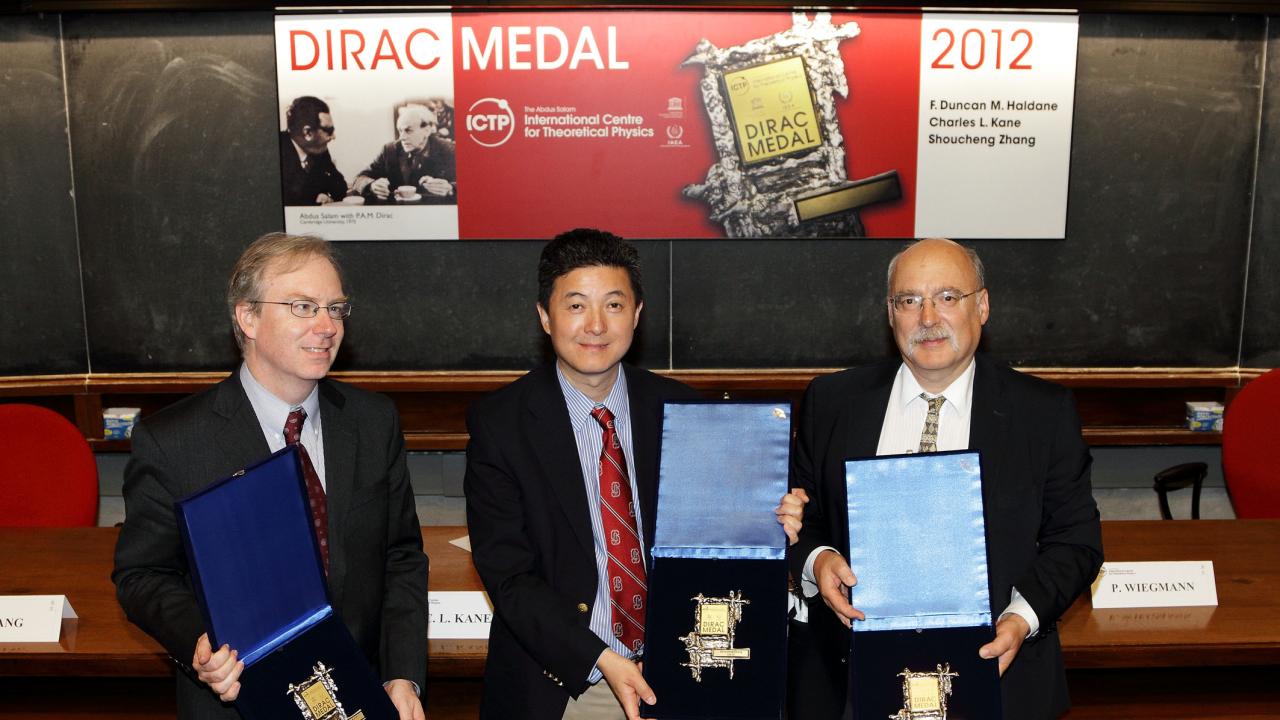
The concept of topological insulators, one of the hottest topics in condensed matter physics today, has spurred extensive research in the realms of theoretical and experimental physics alike. The three condensed matter physicists, F. Duncan M. Haldane (Princeton University, USA), Charles L. Kane (University of Pennsylvania, USA) and Shoucheng Zhang (Stanford University, USA), whose research paved the way for advancing knowledge about topological insulators were presented their Dirac Medals at an award ceremony held on 4 July 2013 at ICTP.
Topological insulators are materials that can conduct electricity at the surface but act as insulators in the interior. One fascinating aspect of the topological insulator research is that the materials were theoretically predicted before being experimentally discovered. Zhang, who theoretically predicted the first topological insulator material, mercury telluride, says, "Initially, I was deeply attracted by the mathematical beauty of topological insulators. But very quickly I realized that this beautiful mathematical structure could be found in nature, in real materials. This was my 'Eureka!' moment."
Paul Wiegmann (University of Chicago), who introduced the medallists to the audience at the ceremony, pointed out that the theoretical prediction preceding the experiments is "an undeniable triumph for theoretical physics."
Topological insulators are expected to find applications in computing and communications technology. "Topological protection in real devices could solve many technological problems such as heat dissipation in semiconductor chips, making computers ever more powerful," explains Zhang. Kane, in his talk, pointed out another theoretical and exciting application--using topological insulators to create the elusive Majorana fermion--a particle that is identical to its own antiparticle; Majorana fermions have been discussed in particle physics for decades, but have so far evaded experimental verification.
The foundation for the development of topological insulators was Haldane's work done in the late 1980's. "I am very happy for the recognition of my old 1988 work on the two-dimensional 'zero-field' or anomalous quantum Hall effect without Landau levels," says Haldane. He adds that Kane's subsequent research with Eugene Mele on this topic "lead to the explosion of theoretical and experimental interest in all things 'topological', and the fundamentally-new, three-dimensional topological insulating systems."
Kane gave the audience a historic perspective on topological insulators and walked them through "the story of topological insulators." "I have spent a good part of my career following trails that Duncan [Haldane] has blazed," he said. He pointed out that receiving an honour in the name of Dirac for research on topological insulators was fitting. "Dirac's profound impact on theoretical physics shows up in almost every aspect of the theory of topological insulators." Haldane drives home the point saying, "Now, condensed matter physics has become invigorated with the discovery of quantum effects stemming in part from the fundamentally topological nature of the Dirac spectrum in one, two, three, and even higher spatial dimensions."
"Topological insulator combines beautiful mathematical structures with experimentally accessible natural phenomena. This is very fundamental for science, and is something Dirac would have liked very much," says Zhang.
ICTP's Dirac Medal, first awarded in 1985, is given in honour of P.A.M. Dirac, one of the greatest physicists of the 20th century and a staunch friend of the Centre. It is awarded annually on Dirac's birthday, 8 August, to scientists who have made significant contributions to theoretical physics. The Medallists also receive a prize of US$ 5,000. The Dirac Medal is not awarded to Nobel Laureates, Fields Medallists, or Wolf Foundation Prize winners, although many Dirac Medallists have proceeded to win these prestigious prizes.
For more details about the Dirac Medal, visit its webpage.
















